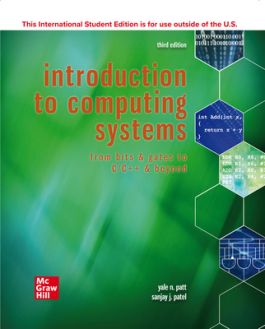Introduction to Computing Systems ISE
3rd Edición
1260569667
·
9781260569667
© 2020 | Published: May 1, 2019
The third edition of Introduction to Computing Systems: From bits & gates to C/C++ and beyond is designed to give students a strong foundation of computing early on in their coursework. The book is in two parts: (a) the underlying structure of…
Leer Más
Gracias este es un libro electrónico o EBOOK, para poder utilizarlo debes de crear una cuenta en VitalSource Bookshelf esta es una Aplicación Gratis. Una vez que has creado tu cuenta, dentro de la plataforma debes de redimir los distintos códigos que hayas adquirido para poder leer tus libros.
Para pagos en BBVA, transferencias interbancarias o tiendas de autoservicio, NO REDONDEAR el monto.
- Ingresa a tu libro desde cualquier lugar o dispositivo, con acceso a internet o sin acceso.
- Crear notas, y apuntes en tus lecturas.
- Puedes realizar búsquedas a los conceptos que necesites de manera rápida y fácil.
1 Welcome Aboard
2 Bits, Data Types, and Operations
3 Digital Logic Structures
4 The von Neumann Model
5 The LC-3
6 Programming
7 Assembly Language
8 Data Structures
9 I/O
10 A Calculator
11 Introduction to C/C++ Programming
12 Variables and Operators
13 Control Structures
14 Functions
15 Testing and Debugging
16 Pointers and Arrays
17 Recursion
18 I/O in C
19 Dynamic Data Structures in C
20 Introduction to C++
Appendix A The LC-3 ISA
Appendix B From LC-3 to x86
Appendix C The Microarchitecture of the LC-3
Appendix D The C Programming Language
Appendix E Useful Tables
Appendix F Solutions to Selected Exercises
The third edition of Introduction to Computing Systems: From bits & gates to C/C++ and beyond is designed to give students a strong foundation of computing early on in their coursework. The book is in two parts: (a) the underlying structure of a computer, and (b) programming in two high-level languages and programming methodology. Taking a bottom-up approach from foundational concepts, such as how a computer operates, to more high-level programming languages enables students to understand each concept while working through the text. This bottom-up approach can lead students to more conceptual understanding and application with less memorizing.

